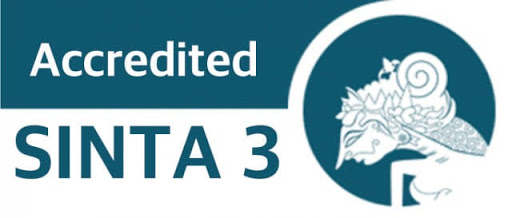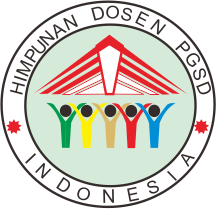Strategies for Using Assistive Technology to Overcome Learning Barriers in Student with Disabillities in Elementary School
Abstract
This study aims to identify the implementation of assistive technology in students with learning disabilities and to identify strategies for using assistive
technology to overcome learning barriers. This research is a literature review (SLR) study conducted on articles from 2013 to 2024 using the Scopus database. The data obtained was saved in *R.I.S. format and synchronized to Reference Manager (Mendeley). Furthermore, VOS-viewer software was used to visualize the data to make the resulting information more interesting and clear. PRISMA flowchart maps the data search process, the number of abstracts screened, and the text retrieved. A total of 8 articles were accessed for this study. The results showed that teachers must prepare themselves well to improve their pedagogical skills by effectively utilizing media and learning resources to achieve the desired goals. Technology or media must adapt teaching materials to the individual needs of students. The results of this study are expected to provide insight into the need for strategies to overcome learning barriers in students with learning disabilities.
Keywords
References
Adebisi, R. O., Liman, N. A., & Longpoe, P. K. (2015). Using assistive technology in teaching children with learning disabilities in the 21st century. Journal of Education and Practice, 6(24), 14–20.
Ahmad, F. K. (2015). Use of assistive technology in inclusive education: making room for diverse learning needs. Transcience, 6(2), 62–77.
Alannasir, W. (2020). Characteristic-based development students aspect. International Journal of Asian Education, 1(1), 29–36.
Bouck, E. C. (2016). A national snapshot of assistive technology for students with disabilities. Journal of Special Education Technology, 31(1), 4–13.
Diana, Sunardi, Gunarhadi, & Yusuf, M. (2020). The use of technology and teachers’ competency development in inclusive education learning: A study in central Java, Indonesia. International Journal of Innovation, Creativity and Change, 13(1), 141–153.
Erdem, R. (2017). Students with special educational needs and assistive technologies: A literature review. Turkish Online Journal of Educational Technology-TOJET, 16(1), 128–146.
Garg, S., & Sharma, S. (2020). Impact of artificial intelligence in special need education to promote inclusive pedagogy. International Journal of Information and Education Technology, 10(7), 523–527.
Gazizovich, N. Z. & N. R. H. (2015). Humanistic Foundation of Inclusive Pedagogy.
Gordon, D., Meyer, A., & Rose, D. (2016). Universal design for learning. CAST professional Publishing Peabody.
Grigorenko, E. L., Compton, D. L., Fuchs, L. S., Wagner, R. K., Willcutt, E. G., & Fletcher, J. M. (2020). Understanding, educating, and supporting children with specific learning disabilities: 50 years of science and practice. American Psychologist, 75(1), 37.
Hallahan, D. E., Kauffman, J. M., & Pullen, P. C. (2013). Exceptional Learners: An Introduction to Special Education: Pearson New International Edition. Pearson Higher Ed.
Hamsar, I. (2023). Perkembangan Peserta Didik Jilid I. Penerbit Tahta Media.
Haug, P. (2017). Understanding inclusive education: ideals and reality. Scandinavian journal of disability research, 19(3), 206–217.
Hernández-Torrano, D., Somerton, M., & Helmer, J. (2022). Mapping research on inclusive education since Salamanca Statement: a bibliometric review of the literature over 25 years. International Journal of Inclusive Education, 26(9), 893–912.
Imaniah, I., & Fitria, N. (2018). Inclusive education for students with disability. In SHS Web of Conferences (Vol. 42, hal. 39). EDP Sciences.
Imene, F., & Imhanzenobe, J. (2020). Information technology and the accountant today: What has really changed? Journal of Accounting and Taxation, 12(1), 48–60.
Izzo, M. V., & Bauer, W. M. (2015). Universal design for learning: enhancing achievement and employment of STEM students with disabilities. Universal Access in the Information Society, 14, 17–27.
Jeong, H., & Hmelo-Silver, C. E. (2016). Seven affordances of computer-supported collaborative learning: How to support collaborative learning? How can technologies help? Educational Psychologist, 51(2), 247–265.
Karynbaeva, O. V., Shapovalova, O. E., Shklyar, N. V., Borisova, E. A., & Emelyanova, I. A. (2017). Formation of professional readiness in teachers for inclusive education of children with health limitations. Man in India, 97(16), 263–274.
Ketrish, E., Fedorov, V., Tretyakova, N., Andruhina, T., & Shehetz, E. (2019). Readiness for work under inclusive education conditions as stage of formation of teacher’s inclusive culture. Elementary Education Online, 18(4), 2109–2127. https://doi.org/10.17051/ilkonline.2019.639443
Kurniati, P., Kelmaskouw, A. L., Deing, A., Bonin, B., & Haryanto, B. A. (2022). Model proses inovasi kurikulum merdeka implikasinya bagi siswa dan guru abad 21. Jurnal Citizenship Virtues, 2(2), 408–423.
Lutfio, M. I., Kapitang, F., Wijaya, M. I., Azizah, Y. L., & Husna, D. (2023). Penggunaan Teknologi Sebagai Media Pembelajaran Pada Anak Berkebutuhan Khusus. Jurnal Pendidikan, 32(1), 121–128. https://doi.org/10.32585/jp.v32i1.3489
Manongga, A. (2022). Pentingnya teknologi informasi dalam mendukung proses belajar mengajar di sekolah dasar. In Prosiding Seminar Nasional Pendidikan Dasar.
Maritsa, A., Salsabila, U. H., Wafiq, M., Anindya, P. R., & Ma’shum, M. A. (2021). Pengaruh teknologi dalam dunia pendidikan. Al-Mutharahah: Jurnal Penelitian Dan Kajian Sosial Keagamaan, 18(2), 91–100.
Mayangsari, I., Salsabila, U. H., Tari, Zulaikha, I. R., & Dewi, F. A. (2020). Pendidikan Teknologi di Sekolah Inklusi pemerintah telah menyediakan fasilitas pendidikan yang khusus untuk anak anak tanpa diskriminasi dimana disekolah ini anak-anak dapat belajar. Jurnal Pendidikan, Sosial dan Kebudayaan, 7, 278–285. https://doi.org/10.32505/tarbawi.v8i2.2195
Mokalu, V. R., Panjaitan, J. K., Boiliu, N. I., & Rantung, D. A. (2022). Hubungan teori belajar dengan teknologi pendidikan. Edukatif: Jurnal Ilmu Pendidikan, 4(1), 1475–1486.
Mooij, T. (2013). Designing instruction and learning for cognitively gifted pupils in preschool and primary school. International Journal of Inclusive Education, 17(6), 597–613. https://doi.org/10.1080/13603116.2012.696727
Naufal, M. H. (2020). Permasalahan Pada Penerapan E-Learning Dalam Pendidikan Inklusi. Jurnal Universitas Lambung Mangkurat, Banjarmasin …, 1–14. Diambil dari https://www.academia.edu/download/65186495/Muhammad_Haris_Naufal_1810117310024_Pendidikan_Inklusi.pdf
Nigmatov, Z. G. & R. R. N. (2015). Study of Distance Learning Opportunities in Inclusive Education System.
Nurfadhillah, S., Septiarini, A. A., Mitami, M., & Pratiwi, D. I. (2022). Analisis Kesulitan Belajar Siswa Berkebutuhan Khusus Slow Learner di Sekolah Dasar Negeri Cipete 4. ALSYS, 2(6), 646–660.
Olmstead, C. (2013). Using technology to increase parent involvement in schools. TechTrends, 57(6), 28–37.
Persico, D., Manca, S., & Pozzi, F. (2014). Adapting the technology acceptance model to evaluate the innovative potential of e-learning systems. Computers in Human Behavior, 30, 614–622.
Podsakoff, P. M., MacKenzie, S. B., & Podsakoff, N. P. (2016). Recommendations for creating better concept definitions in the organizational, behavioral, and social sciences. Organizational Research Methods, 19(2), 159–203.
Puspitarini, Y. D., & Hanif, M. (2019). Using Learning Media to Increase Learning Motivation in Elementary School. Anatolian Journal of Education, 4(2), 53–60.
Rahmi Tanjung, K., Tanjung, R., Setyosari, P., Sukmawati, E., Wirawan, R., Aulia, R., … dan Rekreasi, K. (2024). Nusantara Educational Review Teknologi Pendukung dalam Pendidikan Inklusif: Sebuah Tinjauan Literatur Sistematis. Ner, 2(1), 1–7. Diambil dari https://journal.unusida.ac.id/index.php/ner/
Ravneberg, B., & Söderström, S. (2017). Disability, society and assistive technology. Routledge.
Razumova, E., Ruslyakova, E., Bazhenova, N., Shpakovskaya, E., & Tokar, O. (2019). Innovative technologies of psychological support for children with disabilities. Elementary Education Online, 18(2), 539–548. https://doi.org/10.17051/ilkonline.2019.562012
Rodríguez, C. D., & Cumming, T. M. (2017). Employing mobile technology to improve language skills of young students with language-based disabilities. Assistive Technology, 29(3), 161–169.
Salsabila, U. H., Ilmi, M. U., Aisyah, S., Nurfadila, N., & Saputra, R. (2020). Peran teknologi pendidikan dalam meningkatkan kualitas pendidikan di era disrupsi. Journal on Education, 3(01), 104–112.
Sholeh, M. I., & Efendi, N. (2023). Integrasi teknologi dalam manajemen pendidikan islam: meningkatkan kinerja guru di era digital. Jurnal Tinta: Jurnal Ilmu Keguruan Dan Pendidikan, 5(2), 104–126.
Snyder, T. D., De Brey, C., & Dillow, S. A. (2019). Digest of education statistics 2017, NCES 2018-070. National Center for Education Statistics.
Susanti, R. D. (2018). Strategi Guru Kelas Dalam Mengatasi Kesulitan Belajar Akademik Siswa Dalam Pembelajaran Di Sekolah Dasar. Konseling Edukasi “Journal of Guidance and Counseling,” 2(1), 139–154. https://doi.org/10.21043/konseling.v2i2.4470
Suskie, L. (2018). Assessing student learning: A common sense guide. John Wiley & Sons.
Suyuti, S., Wahyuningrum, P. M. E., Jamil, M. A., Nawawi, M. L., Aditia, D., & Rusmayani, N. G. A. L. (2023). Analisis Efektivitas Penggunaan Teknologi dalam Pendidikan Terhadap Peningkatan Hasil Belajar. Journal on Education, 6(1), 1–11.
Warman. (2021). Establishing the governmental policy to promote engagement within the inclusive education system in Indonesia. Journal of Social Studies Education Research, 12(1), 124–148.
Woolfolk, A. (2016). Educational psychology. Pearson.
Xiao, Y., & Watson, M. (2019). Guidance on conducting a systematic literature review. Journal of planning education and research, 39(1), 93–112.
Xie, H., Chu, H.-C., Hwang, G.-J., & Wang, C.-C. (2019). Trends and development in technology-enhanced adaptive/personalized learning: A systematic review of journal publications from 2007 to 2017. Computers & Education, 140, 103599.
Zabir, A. (n.d.). Pengaruh Pemanfaatan Teknologi Pembelajaran Terhadap Motivasi Belajar Siswa SMPN 1 Lanrisang Kabupaten Pinrang. Diambil dari http://zafar14.wordpress.com/2010/04/25/keberhasilan-belajar-dan-berbagai-upaya-untuk-memotivasi-siswa-dalam-belajar/
DOI: http://dx.doi.org/10.33578/pjr.v9i1.10102
Refbacks
- There are currently no refbacks.
Copyright (c) 2025 JURNAL PAJAR (Pendidikan dan Pengajaran)

This work is licensed under a Creative Commons Attribution-NonCommercial-ShareAlike 4.0 International License.
JURNAL PAJAR (Pendidikan dan Pengajaran)
Secretariat
Program Studi Pendidikan Guru Sekolah Dasar
Gedung B1, FKIP Universitas Riau
Kampus Bina Widya Km. 12,5 Simpang Baru Panam
Pekanbaru Riau Indonesia 28293
e-mail : pajar@ejournal.unri.ac.id



